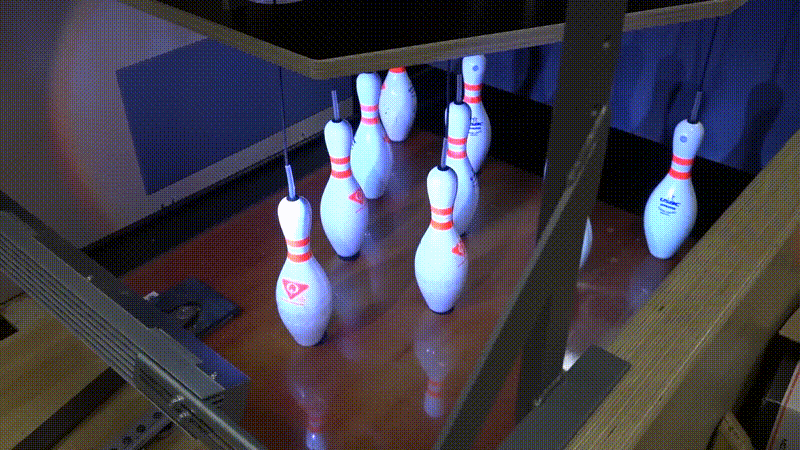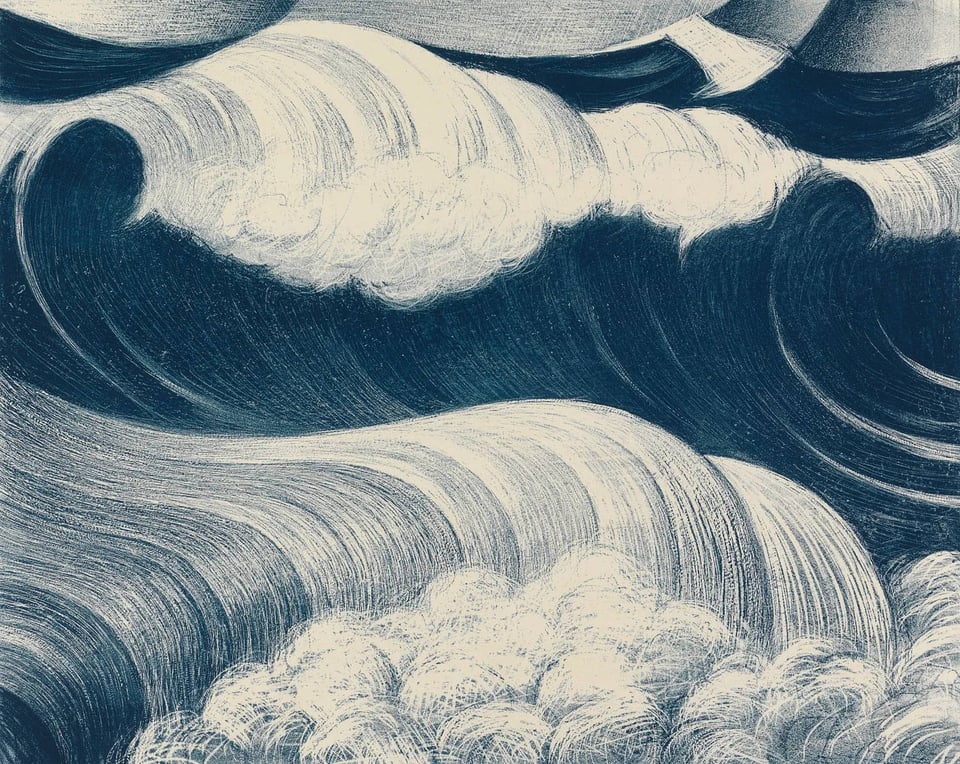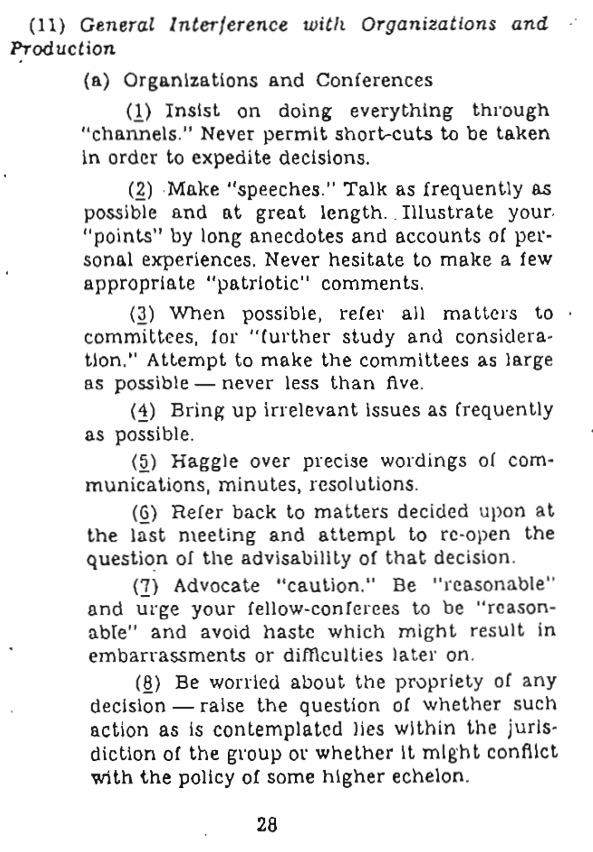Linkfest #15: Altruistic pigs, the "Truetown Discharge", and the CIA's guide to wrecking meetings
Welcome to the latest edition of the Linkfest! "The opposite of doomscrolling", as I call it 😅
Thank you for subscribing -- and if you’re enjoying it, spread the word! Forward this newsletter far and wide to anyone who you think might enjoy it. There's a pay-what-you-want signup here; the folks who can afford to contribute help keep it free for everyone else.
Let's get to it -- here's the finest Internetstuff I found and collected, just for you ...
1) 🎳 The fight over new pin-setting technology in bowling

For decades, American bowling lanes have used a complex pin-setting technology: After the ball sends the pins scattering, a contraption grabs the ones still standing and lifts them out of the way -- so another arm can sweep the fallen pins back.
It's a fiddly mechanical process that breaks a lot, so it's expensive.
To bring the price down, American bowling lanes have recently begun to roll out a simpler system: The pins hang from strings, so they can be lifted out of the way more easily. It's cheaper and breaks less often.
But! It changes the physics of the pins ... and bowlers loathe it.
David Wharton wrote a fascinating piece about this tech/culture fight for the LA Times ...
Even their hardest throws fail to produce the “explosion” bowlers crave, the pins merely wobbling and skittering. Each near-miss prompts second-guessing. [snip]
Nothing could be done about the muted sound. It’s like hearing a drum roll — the ball charging down the lane — with no crashing cymbal at the end. That crescendo and climax, Mills insists, is a visceral part “of the experience of smashing pins with a heavy ball.”
Makers of the new tech have tried to improve it as best they can. But, dammit, these newfangled strings still make it harder to get a strike:
Researchers toyed with cord length and modified the walls surrounding the deck area, where the pins stand. They found a configuration that resulted in 7.1% fewer strikes and about 10 pins fewer per game as compared to bowling with traditional pinsetters.
Super cool piece -- go read the whole thing!
2) 📚 The book covers you never get to see

When you see a book cover, you're often looking at the second, third, fourth, or seventeenth design.
Typically the designer will come up with an idea, but other folks -- the salespeople, the author, the editors -- want to see a different treatment. So the world of book-jacket design is filled with concepts the public never gets to see.
Over at Fast Company, Zachary Petit collected together several original designs -- from famous recent books -- that never made the cut, and gets the story behind them. That one above? It's the original cover for Couplets, with a photo of the author cut in half so that it composites cleverly when you lay copies of the book side by side.
The problem is, most people won't see the book laid side by side with other copies, and the design is less interesting when you only see one. So the publisher, correctly I think, went another way.
Petit argues that many of the original-but-discarded designs are better than the final ones ...
killed covers are often where you can find the really great stuff. The surprising work. The refreshingly genre-breaking, exciting, unfiltered output that nudges the field toward its next evolution.
Go check out the whole story; he's got eight more examples of other covers!
3) 🌊 A new formula for predicting rogue waves

Rogue waves are terrifying and lethal. They emerge out of the ocean with no warning -- walls of water that tower above other waves, destroying ships. To try and protect against them, scientists over the last twenty years have crafted formulae to try and predict how they'll emerge. Results were limited.
But a new group of researchers has produced what they say is the best formula yet. They built a small neural net and trained it using 1.4 billion wave measurements from ocean buoys. Once the neural net was producing good results -- and predicting rogue waves with better accuracy than previous formulas -- they transformed its processes into a regular equation. (Which they were able to do because they kept the neural net so comparatively tiny!)
So theoretically, if you had good enough real-time knowledge of water conditions, you could predict the emergence of a rogue wave. (That's a big "if", mind you.)
They also made a cool discovery: What really causes rogue waves in the first place ...
Until the new study, many experts believed the majority of rogue waves formed when two waves combined into a single, massive mountain of water. Based on the new equation, however, it appears the biggest influence is owed to “linear superposition.” First documented in the 1700’s, such situations occur when two wave systems cross paths and reinforce one another, instead of combining. This increases the likelihood of forming massive waves’ high crests and deep troughs. Although understood to exist for hundreds of years, the new dataset offers concrete support for the phenomenon and its effects on wave patterns.
4) 🐖 Are pigs altruistic?

Over at Science magazine, David Grimm has a truly spectacular piece about researchers who are probing the mental lives of farm animals.
It's a delightful read. Grimm profiles a lab where the scientists are, for example, discovering that you can potty-train cows. Why is that significant? It means cows can be self-aware of their incipient need to pee or poop -- and then, being aware of it, can suppress it. For decades, scientists really didn't think cows had that level of self-awareness.
In other experiments, they've found that goats will behave altruistically -- grabbing a branch laden with apples and pulling it down so their fellow goats can eat.
Pigs will help other pigs, too! They set up a box where pigs can wander inside and get stuck, and found that other pigs on the outside will poke around until they figure out how to set the trapped one free ...
The liberators were more likely to open the box when a pig was trapped inside than when it was empty, ruling out mere curiosity. Those that spent more time staring at their trapped companion were also more likely to help, especially if that companion squealed in distress, suggesting the helpers were sensitive to the “emotional state” of the boxed pigs.
“We think the helping behavior is based on some understanding of the other’s needs,” Moscovice says. “That’s a critical component of empathy that’s really exciting to see.”
Critics have argued that animals might help others simply to alleviate their own stress at seeing or hearing a trapped companion. But saliva samples Moscovice collected did not show elevated levels of the stress hormone cortisol in the helper pigs, consistent with a more selfless reason for the assistance.
Seriously, this piece is great. Here's an unpaywalled link in case the one above hits you with a paywall.
5) 🌃 Joshua Smith's teensy buildings

Joshua Smith is an artist who creates amazingly detailed scale-models of buildings and street scenes. As he tells Colossal ...
“My work focuses on often neglected and abandoned buildings, which more often than not are covered in graffiti, rust, and grime,” the Adelaide, South Australia-based artist tells Colossal. Rendering corner stores, photo booths, and anonymous entryways with precision, he adds layers of lifelike details both inside and out, from stacks of boxes to checkout counters to racks of merchandise.
It's amazing stuff -- check out his Instagram, his web site (where some of his work is for sale), and that Colossal story on him!
6) 🎶 Guitar with a rotating cylindrical neck

Ingenious (if weird) engineering: This guy created a guitar that has tube for a neck that's mounted with guitar strings on side, and bass strings on another (video). You can play whichever you want, and spin it around mid-song to switch instruments.
His video is mostly a retrospective on how hard it was to build the thing, but if you scroll to the ten-minute mark he plays it. It does not sound terrific -- as he readily admits -- but it's amazing it works at all.
7) ☎️ The CIA's guide to disrupting meetings

How do you slow down an economy?
By making its meetings as lugubrious and unproductive as possible!
That was the epiphany of the Office of Strategic Services, the predecessor to the CIA, back in 1944. They figured that maybe they could get sympathetic citizens in Axis countries to go to meetings -- civic or industrial -- and slow things down. So the OCC wrote up a brochure filled with devious ways to make meetings as useless as possible.
When you read them now, they feel like a precise description of all the things that make your meetings at work (or a city council) complete torture.
8) 🪰 Cicadas so loud fiberoptic cables can hear them

"Distributed Acoustic Sensing" is a cool technique that scientists are using to track seismic activity. Basically, you shoot a laser through fiber-optic cables -- which are buried all over the US -- and measure any perturbations. Even tiny earthquakes and shiftings of the land can be measured.
In the spring of 2021, though, some New Jersey researchers started getting a weird, constant buzzing in the cables. As Matt Simon reports in Wired, they finally figured it out ...
... the “something” wasn’t a rumbling volcano -- not in New Jersey—but the cacophony of the giant swarm of cicadas that had just emerged from underground, a population known as Brood X. A colleague suggested reaching out to Jessica Ware, an entomologist and cicada expert at the American Museum of Natural History, to confirm it. “I had been observing the cicadas and had gone around Princeton because we were collecting them for biological samples,” says Ware. “So when Sarper and the team showed that you could actually hear the volume of the cicadas, and it kind of matched their patterns, I was really excited.”
They inadvertently discovered a new way to measure the health -- or decline -- of insect populations: Use our existing networks of buried fiber-optic cables to listen to them. Since those cables are very often laid down for data access, this is deeply and profoundly rad: We're using the Internet to listen to insects ...
“What seems really cool about this new technology is that you have this single cable that can cover potentially many kilometers, and all of the information is getting recorded by a single device,” says Elliott Smeds, an entomologist and research associate at the California Academy of Sciences, who wasn’t involved in the research. “Especially now that insects are declining, we’re realizing that we don’t even know what the baseline is for a lot of these species, to keep track of how they’re doing. The biggest obstacle is having enough boots on the ground to be collecting this kind of data.”
9) 🌿 Turning toxic mine-drainage into oil paints

This is a strangely beautiful story: An Appalachian town is turning its toxic heritage into tools for art.
It's the town of Millfield, where the waterway has been hideously polluted for years by mining ...
In rural Millfield, 35 miles or so from the West Virginia border, the Truetown Discharge has been bubbling out of the mine once known as AS-193 for nearly 40 years. Since 1984, it has dumped billions of gallons of water loaded with sulfuric acid and iron oxide — otherwise known as acid mine drainage — into Sunday Creek. In 1997, an Ohio Environmental Protection Agency report found that 13 miles of the waterway were, essentially, dead: “irretrievably damaged to the extent that no appreciable aquatic life can be supported.” With nearly 1,000 gallons released every minute, this is the largest and most extreme acid mine drainage site in the state.
Now the city is managing a project to turn that toxic runoff into oil paints, for artists:
Rural Action and its partners created True Pigments, LLC. At its future headquarters in Millfield, the company will transform acid-mine drainage into raw material that’s used to create paints and tints for commercial products from bricks to blush, all while creating local jobs, cleaning up the creek, and making enough money that the whole thing pays for itself. The first product made with iron oxide from Sunday Creek is a set of oil paints created by Gamblin Artists Colors. The three-pack of pigments — Brown Ochre, Rust Red, and Iron Violet — is called “Reclaimed Earth Colors.”
Go read the whole piece, by Kate Morgan in Vox. (There's a short piece also at the Ohio University web site; some professors are involved in this.) It sounds like they're only at the beginning, but if they can really do this, my hat is off.
As an aside, the name they've given that pollutant -- the "Truetown Discharge" -- would make a great title for a bluegrass song about this whole affair, which I now allllmost thinking of writing for my country band The Delorean Sisters, lol.
10) 🎲 A final, sudden-death round of reading material
America's Grandest Gas Stations. 🎲 VR goggles for mice. 🎲 "Ghost" social-media interactions. 🎲 Audio Hijack, a Mac-only voice-to-text app that works entirely locally. 🎲 A worm that detaches its butt to go seek a reproductive partner. 🎲 A defense of the exclamation mark. 🎲 Modern tech is revolutionizing braille. 🎲 Penguin micro-naps. 🎲 Using "backtrack" mode on the Apple Watch compass to get un-lost. 🎲 The finalists to be Minnesota's new, modernized flag. 🎲 Six-sided pen you roll like a die. 🎲 Rocket summer. 🎲 100-year-old fish. 🎲 The neuroscience of four and five. The "formose reaction". 🎲 "The microbe may have been slumbering for millions of years before being awakened by an industrial disaster." 🎲 A tachitoscope that displays subliminal messages. 🎲 The history of charisma. 🎲 The evolution of "AI" as a "count noun". 🎲 How to design the psychological hooks of video-game loot. 🎲 What the acronym "M&Ms" stands for. 🎲 The Bronx Zoo platypus that faked a pregnancy. 🎲 100% of the words in Wikipedia's "Ship of Theseus" entry have been replaced. 🎲 Plants may be absorbing 20% more CO2 than we thought. 🎲 Why so many companies use the sparkle emoji (✨)to stand for AI. 🎲 The great "Poets' Brawl" of 1968. 🎲 The $3.99 thrift-store vase that was worth $100,000. 🎲 A gigantic wooden D20. 🎲 Tool for generating SVG images of starry skies. 🎲 Lamps on the moon. 🎲 Glass storage.
Coda: I read hundreds of blogs and news sites every week to find this stuff. Shoutout to one I relied on particularly this week -- Charles Arthur's The Overspill. Go check it out!